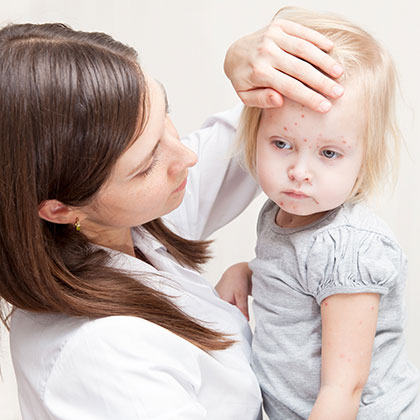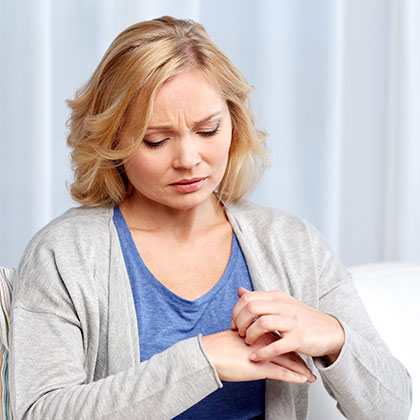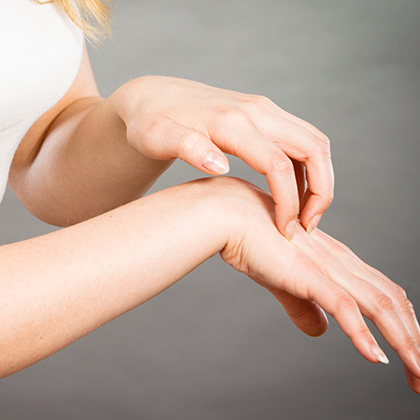
Some types of worms are parasites that infect humans. Also called helminths (which comes from the Greek word for worms), they live in your body and feed off you. While this sounds alarming, according to the NHS most worm infections aren’t serious and are easily treated (i).
Worm infections are very common worldwide, though most cases are found in areas where there is poverty, poor sanitation and poor hygiene. There are three main worm groups:
-
Roundworms include threadworms and hookworms, which live in the intestines.
-
Tapeworms also live in the intestines and are usually found in people who have eaten raw or uncooked meat.
-
Flukeworms can live in other parts of the body as well as the intestines, including the blood vessels, gut, lungs or liver. Flukeworm infection causes a tropical disease called schistosomiasis. Infection is caused by swimming or washing in fresh water that contains flukeworms.
Ringworm, on the other hand, isn’t caused by worms, but is a common fungal infection that causes a red or silver rash that’s usually ring-shaped.
Most worm infections affect people in tropical or developing countries. Here in the UK, however, the most common worm infection is threadworms – a common infection in children.
Threadworms: what you should know
According to the National Institute for Health and Care Excellence (NICE), threadworm infection can affect anyone but is mainly found in children under the age of 18, along with people living with infected children and those living in institutions. Exactly how many are affected isn’t known, but NICE estimates up to 40 per cent of children will have threadworm infestation at some time in their lives (ii).

The reason we don’t know how many people in the UK have threadworms is that many may treat them themselves, without consulting a doctor. However, according to Patient.co.uk – which suggests children between the ages of five and nine years are the most affected – an average GP practice of 10,000 patients would expect around 40 consultations a year for threadworms (iii).
Threadworms – or Enterobius vermicularis – are also sometimes referred to as pinworms. You become infected by swallowing or inhaling their eggs, which can survive for up to two weeks outside the body. In this country, this often happens when a child touches something that’s been infected by worm eggs and then touches their mouth or nose. Contaminated surfaces and objects can include things like toys, bedding, clothing, food, kitchen and bathroom surfaces and toothbrushes.
In other parts of the world where there is poor food hygiene or no modern toilets or sewage systems worms can also be passed on if you touch soil or swallow water or food with worm eggs in it, if you walk barefoot on soil that contains worms, or if you eat raw or undercooked beef, pork or freshwater fish that’s infested with worms.
Meanwhile, according to NICE, humans are thought to be the only host for threadworms, which means you cannot catch them directly from pets (iv).
Threadworm lifecycle
Threadworms are so named because they look like little pieces of white thread: adult male threadworms (which are rarely seen) are smaller at 2 - 5mm in length, with adult females 8 - 13mm long and just under 1mm in diameter.
Threadworms live for five to six weeks in human intestines, but before they die the females lay eggs that are too small to see with the naked eye (a female threadworm can lay an average of 11,000 of these tiny eggs during her lifetime). They migrate out of an infected child’s anus at night, laying their eggs on and around the anus (in girls the worms may also lay their eggs around the vagina and urethra). It’s thought that the reason threadworms come out at night is because children are still and warm when they’re in bed asleep.
However, the mucus that’s secreted along with the eggs is an irritant that causes intense itching. So, when children scratch the affected area they get eggs on their hands and under their fingernails. If they don’t wash their hands, they can then contaminate anything they touch. They can also re-infect themselves if they touch their mouths when they have eggs on their hands. The eggs can also fall off the skin around the anus and fall on to objects and surfaces – they can even become part of the dust in your home.
If a child swallows – or possibly inhales – any threadworm eggs, they hatch and grow into adult worms in their intestines, becoming adult worms within a couple of months. So, unless steps are taken to eradicate threadworms, the infection can go on and on.
What are the symptoms?
The most common symptom of a threadworm infection is intense itching around the anal area, especially at night, often causing sleep difficulties. Pre-pubescent girls may also experience other symptoms such as a vaginal discharge, urinary tract infection or bedwetting.
If a child has large numbers of threadworms they may also have a mild stomach ache and feel irritable. In a small number of cases, threadworms can cause other problems include weight loss and loss of appetite. Scratching can also cause inflammation and, if the affected skin is broken, an infection.
You may also want to confirm your child has threadworms by checking their stools – the worms look like thin, white, cotton threads – or by checking around their anus at night. If you’re still unsure, your GP may suggest doing a sticky tape test, which involves pressing some clear tape on the skin around the anus first thing in the morning. Your GP will send the tape to the lab, where it can be checked under a microscope for the presence of tapeworm eggs.
If your child does have a threadworm infection, it’s important to treat everyone in the household, even those who don’t have any symptoms. There are two ways of treating an infestation – either using the hygiene method or by taking medication in combination with hygiene measures.
If, however you have a threadworm infection and you’re pregnant, breastfeeding or you have a baby under three months old, always see your GP for advice.
How to treat threadworms: hygiene
You should stick to the hygiene method strictly for six weeks if you’re not using any medication for threadworms. This not only clears up a threadworm infection but it also reduces the chances of re-infection, since the lifespan of a threadworm is approximately six weeks.
First, take the following steps to get rid of eggs from your home:
-
Vacuum and dust your house thoroughly. Dust using a damp cloth and throw the cloth out afterwards. Pay attention to bedrooms – especially your child’s bedroom – and vacuum all areas where they play as well as their mattress.
-
Clean all bathroom and kitchen surfaces by damp dusting them, rinsing the cloth in hot water frequently and throwing it away when you’ve finished.
-
Wash all bedding and towels, as well as nightwear and cuddly toys (this can be done at normal temperatures). Try to avoid shaking any material that may have eggs on it, such as bed sheets or clothing, as this can transfer the eggs to other surfaces. Don’t let your child eat any food in their bedroom, as they may swallow eggs that have been shaken off their bedding.
-
Continue to clean your home thoroughly, even after the infection has cleared up.
Next, everyone in your household should follow the following steps, again for at least six weeks:
-
Wash hands frequently and thoroughly, scrubbing under the nails with a nail brush. Make sure you always wash your hands before eating, after going to the toilet and after changing a nappy. Teach your child how to wash their hands properly – watch this NHS video that shows the correct hand washing technique.
-
Keep fingernails short
-
Try to make sure your child doesn’t bite their nails or suck their fingers or thumb.
-
Also try making your child wear cotton gloves at night, as it may help stop them scratching themselves with their fingernails. Wash the gloves each morning.
-
Wear close-fitting underpants at night and change them every morning. Ideally change and wash your nightwear every day too.
-
Bath or shower regularly, ideally first thing in the morning as soon as you get up, and make sure you clean around your anus and vagina to remove any eggs (or wash the genital area thoroughly straight after getting up from bed if you prefer to bathe at night).
-
Don’t share towels or flannels with anyone else – make sure everyone in your household has their own.
-
Put toothbrushes in a closed cupboard when they’re not in use and rinse them thoroughly before you use them.
After the infection has cleared up it’s a good idea to encourage your child to continue washing their hands frequently, as it could help prevent them picking up another threadworm infection from another child at school. If you continue with good hygiene measures around the home, it may also help prevent another outbreak.
How to treat threadworms: medicines
If you decide to take medication for threadworms, again everyone in your household should take it – but the amount of time you have to follow strict hygiene measures is reduced from six weeks to two.
The most common medicine used to treat threadworm infections is mebendazole. This kills threadworms by stopping them from absorbing the sugars they need to survive – though it cannot kill threadworm eggs. You can buy it over the counter at pharmacies in liquid form or as chewable tablets (your GP can also prescribe it). It’s the preferred treatment option for children over two years of age (though in some cases it can be prescribed by a doctor for children as young as six months). You may be advised to take a second dose of mebendazole two weeks after the first, as it can help prevent re-infection.
Mebendazole is generally well tolerated and rarely causes side effects, However, if you have a very severe threadworm infection, it can cause abdominal pain or diarrhoea, though this is thought to be quite rare. You should also avoid taking mebendazole if you’re pregnant or breastfeeding – though if treatment is absolutely necessary, it’s considered safest to take during the second or third trimester.
Other threadworm medicines
If your child is younger than two years old but older than three months, they may be able to take a medicine called piperazine. This works by paralysing the threadworms until they are eliminated from the bowel naturally, and is usually combined with senna, a medicine that has a laxative effect to help get rid of the worms more quickly.
Piperazine and senna usually come as powders in sachets that are mixed with milk or water before drinking. Again, you may need a second dose after two weeks, as piperazine cannot kill threadworm eggs. It’s not suitable, however, for those who have epilepsy or problems with their liver or kidneys.
Both mebendazole and piperazine are believed to be between 90 - 100 per cent effective at killing threadworms (v). Other possible drugs for treating a threadworm infection include albendazole and pyrantel pamoate (vi).
What else can you do?
Good hygiene is the key to preventing threadworms, especially frequent hand washing and particularly before eating and after going to the toilet. You also don’t have to keep your child at home if they’re infected, because if you follow the hygiene method they shouldn’t have any eggs on their hands when they go to school or nursery as they will have washed their hands thoroughly. This means the risk of them infecting other children will be low.
Meanwhile you could also take steps to make sure your child is healthy if they have threadworms. Try making their diet as healthy and nutritious as possible and encourage them to stay active and to get plenty of sleep (though a tapeworm infection can make sleep difficult, thanks to the nocturnal itching).
You can also boost their diet with supplements that help make sure they’re getting the nutrients their body needs. Some you may want to consider include:
-
Supplements that help support their immune system, including child-friendly products with immune-boosting ingredients such as elderberry, blackcurrant and rosehips.
-
A multivitamin and mineral formulated for children – look for products that children will enjoy taking, such as chewable tablets or tablets that dissolve in water to make a palatable drink.
-
A natural soluble fibre supplement to boost their digestive system – some are available in powder form and are sweet tasting, which may make them easier for children to take.
-
A live bacteria supplement may also keep their digestive system happy – look for a low-level product that’s suitable for children.
When sourcing nutritional supplements for children it’s a good idea to use a reputable company that can give you advice about the products that may be suitable for them. Always ask if you’re not sure whether you should give your child any particular supplements.
References:
-
Available online: https://www.nhsinform.scot/illnesses-and-conditions/stomach-liver-and-gastrointestinal-tract/threadworms
-
Available online: https://cks.nice.org.uk/threadworm#!backgroundSub:1
-
Available online: https://patient.info/doctor/threadworms-pro
-
Available online: https://cks.nice.org.uk/threadworm#!backgroundSub
-
Available online: https://psnc.org.uk/avon-lpc/wp-content/uploads/sites/23/2013/08/Threadworm-Leaflet-A.pdf
-
Georgiev. V. Chemotherapy of enterobiasis (oxyuriasis). Expert Opin Pharmacother. (2001 Feb). 2(2):267-75. Available online: https://www.ncbi.nlm.nih.gov/pubmed/11336585?dopt=Abstract
Related Posts
Disclaimer: The information presented by Nature's Best is for informational purposes only. It is based on scientific studies (human, animal, or in vitro), clinical experience, or traditional usage as cited in each article. The results reported may not necessarily occur in all individuals. Self-treatment is not recommended for life-threatening conditions that require medical treatment under a doctor's care. For many of the conditions discussed, treatment with prescription or over the counter medication is also available. Consult your doctor, practitioner, and/or pharmacist for any health problem and before using any supplements or before making any changes in prescribed medications.

Christine
Christine Morgan has been a freelance health and wellbeing journalist for almost 20 years, having written for numerous publications including the Daily Mirror, S Magazine, Top Sante, Healthy, Woman & Home, Zest, Allergy, Healthy Times and Pregnancy & Birth; she has also edited several titles such as Women’ Health, Shine’s Real Health & Beauty and All About Health.
View More



